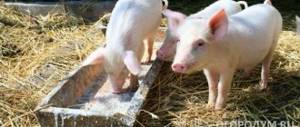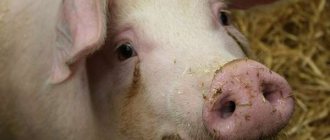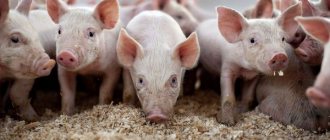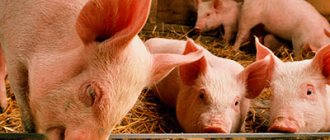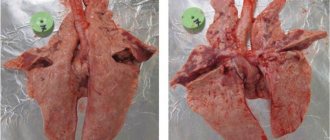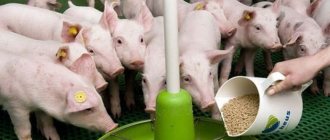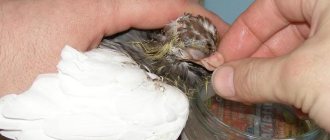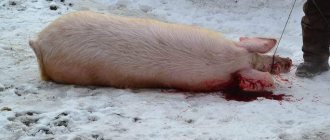Why do you need to scorch?
It is necessary to singe a pig correctly, first of all, to rid the skin of bristles. In addition, cleaning often precedes smoking and affects the quality of the lard. If the pig is slaughtered for sale, it is necessary to singe it to give it a marketable appearance.
The choice of bristle removal partially affects the quality of the lard. If you tar a pig, the lard acquires a specific taste. It is usually advised to smoke and salt the carcass immediately after it has been seared.
Theoretically, a young piglet can be left with bristles, and during cooking you can simply remove the skin. However, this will prevent you from using the pigskin. The bristly material is not suitable for dressing and processing, and it is almost impossible to get rid of hair on a skin that has already cooled down.
Technology of singeing a pig with straw
Each pig farmer must send the raised livestock to slaughter after fattening to obtain meat products.
There are several options here:
- sending animals to slaughter;
- inviting a specialist with slaughter skills to the farm;
- independent slaughter.
When using the latter method, the farmer can significantly save money, but at the same time the person must know exactly what actions to perform and in what sequence. It is not enough to kill the animal, it must be properly butchered. Next we will talk about how to singe pork skin.
Stubble removal methods
If you decide to use leather, you need to choose how to remove the stubble. The most convenient and accessible method is chosen. It is recommended to get rid of stubble using one of 4 methods:
- straw, wood chips;
- gas burner;
- blowtorch;
- scalding.
Each method has its own disadvantages and advantages. However, in each case it is necessary to be careful and pay attention to the process. This plays a decisive role. It is important not to dry out the skin using fire and not to cook the carcass by removing the bristles with water.
There are alternative methods - cleaning the hide with chemicals. However, it is not recommended to do this at home. In addition, it is worth remembering the harmfulness of such methods.
Singing a pig is not enough. It is necessary to scrape off soot and burnt bristles. Usually a scraper, a knife, or a blade are used. Alternative methods - a hard brush and sandpaper are not effective enough; after the process, most of the bristles and soot remain.
Important! Properly tarring a piglet is especially important for farmers who do not use the services of slaughterhouses. Some slaughterhouses give the owner a fully prepared, dressed carcass.
How to render pig fat
Rendering lard
.
The internal lard is rendered in a copper pan or, if the rendering is done over bare fire, preferably in a cast-iron cauldron. First, water is poured into the cauldron and then evenly cut pieces of well-washed lard are placed and heated. Water protects the lard from burning. Towards the end of rendering the lard, the cast iron is heated over moderate heat until the pork cracklings
turn brown and rise to the top. The lard is stirred frequently, then cooled and filtered through a canvas or metal sieve. When cooling, the lard is also stirred to make it whiter. Internal lard must be rendered separately from subcutaneous lard, since it melts faster, and in addition, it produces the most valuable type of lard. When heating subcutaneous fat and various trimmings, the skin and remaining meat should be cut off. Intestinal lard is always rendered separately, as it spoils good lard with its smell.
How to properly singe a pig with a gas torch
It is convenient to singe a pig with a gas burner because you can efficiently clean hard-to-reach places. An additional advantage is that you can make a gas burner for scorching pig carcasses yourself. Tarring should be done according to this scheme:
- The carcass is placed on a raised platform, preferably on its back, legs spread apart.
- Turn on the gas burner and gradually singe the skin.
- It is recommended to repeat the procedure 2 times - scorch, scrape, repeat again.
- During the process, make sure that the skin does not dry out. Bubbles of fat indicate the degree of readiness.
A gas torch for singeing pigs is safer than a blowtorch. The burner does not have the property of heating up. The disadvantage of this method is that it simply dries out the skin and singes the skin in addition to the bristles. You can ruin the top layer of lard.
How to properly butcher a pig
Cutting a carcass requires knowledge of the physiology of the animal, otherwise awkward movements can spoil valuable products. First, the head is separated from the body. Next in line is the tender layer of fat and meat located on the abdomen.
Next you have to get “inside”. To do this, you need to cut the sternum with an ax. It’s too early to remove the meat, otherwise you can hit the esophagus and the contents will end up on the product. First of all, it is necessary to tightly bandage the esophagus, then trim it and carefully remove it from the carcass.
The organs removed next in order of proximity to the surface are the heart, lungs and diaphragm, stomach and intestines. The organs are removed carefully, since they are all suitable for use as food.
The liver should be cut out very carefully, because the gallbladder is located nearby, and damage to it can impart bitterness to the meat. At the same time, layers of internal fat are cut off.
The remaining organs - the kidneys and bladder - are also removed separately.
The carcass, cleaned of internal organs, must be thoroughly washed. This will keep the meat fresh and flavorful longer.
So, the answer to the question of how to quickly slaughter a pig is clear - with a knife in the heart, but it is advisable for a beginner to observe the process from the outside in advance, or invite an experienced slaughterer. The second method, cutting the artery, is less humane, but has the advantage of yielding better quality meat.
How to make a gas burner for processing pigs
Not having a tool at home is a reason to make the device yourself. You can make a burner for singeing pigs with your own hands. The design includes the following elements:
- body (metal);
- nozzle;
- gearbox;
- a unit for attaching a gas cylinder;
- regulator to control fuel supply;
- gas hose;
- lever;
- flame blow-out safety device;
- head.
Detailed manufacturing instructions are demonstrated in numerous videos. Create a gas burner for pigs with your own hands according to the following scheme.
- First, the handle is made. It is acceptable to use an old soldering iron handle or unnecessary pipes. The handle should remain cold.
- Create a steel body. It is permissible to use a brass rod with a diameter of 2 cm.
- The divider is made from the same rod, with 4 holes for oxygen circulation. The lack of oxygen will make combustion impossible.
- The divider is pressed forcefully into the body. It is necessary to install an internal flange with clearance.
- They make a nozzle. A metal rod is used for this. A drill with a diameter of 2 mm makes a blind hole. A 4 mm hole is made in the jumper. They are hammered and sharpened with sandpaper.
- A gear hose (rubber or fabric) is attached to the end of the tube and secured with a clamp or screwdriver. The hose is taken from specialized materials; using improvised materials is risky.
- Then the optimal pressure in the connected gas cylinder is set.
Important! A homemade gas burner is suitable for singeing a pig in the same way as a purchased one. The difference is the level of security. The purchased model is a guarantee that the tool meets the required standards.
How to singe a pig or pig with straw
Singing a pig with straw is considered a crude but simple method to treat the carcass. Some recommend using this method only when preparing a carcass for yourself, and tarring piglets for sale using other methods.
- The carcass is placed on the ground. A heat-resistant table is suitable, but the ground is more convenient; removing ashes and scraping stubble will be more convenient in an unlimited space.
- Cover the side with straw and set it on fire. You should watch the combustion. Strong flames should be put out with burlap.
- The ashes from the burnt straw are removed along with the burnt bristles. It is advisable to use additional tools.
- Turn the carcass over and repeat the steps. It is important to place the straw evenly on both sides of the pig.
Properly singeing a pig with straw is quite simple. If necessary, straw is replaced with thin aspen chips. Scorching a pig with wood chips is faster than scorching with straw due to the high temperature of the fire. Soot and bristles should be scraped off carefully using a scraper. Some people recommend scrubbing with a stiff brush, but this method is ineffective.
How to tar a pig or pig with a blowtorch
The blowtorch method is similar to the gas torch method. The difference is that the pig will be processed using propane.
- The pig carcass is placed on the table for convenience. It is more convenient to leave a large pig on the ground.
- Turn on the blowtorch. It is advisable to adjust the temperature before scorching the pig.
- Carefully singe the bristles, including in hard-to-reach places. Scorching will take time, you should take into account the necessary breaks, it will take longer than cleaning a pig with a gas torch.
- The carcass is turned over as needed. The ears, head, and tail are treated especially carefully.
- Some people advise doing tarring twice, cleansing the skin as thoroughly as possible.
It must be remembered that the blowtorch gets hot. You will need to take breaks from working; some blowtorches explode due to overheating. The process will take longer than if you scorch with straw or a gas burner. The advantage of a blowtorch is the ability to process the pig more thoroughly than with other methods.
It is advisable to scrape the skin with a blade, scraper, or knife. But it is important to remember that the skin should not be damaged. You should not overdry the skin; you should also not singe it to the point of charring the skin.
Important! A blowtorch and gas burner make it possible to process the carcass deeply, adding aroma and flavor to the meat. Tarring with straw is convenient, but it will be difficult to scorch deeply.
How to singe a pig to add flavor
After removing the bristles, it is recommended to do an additional roasting, which gives the lard and meat a specific aroma.
- The carcass, devoid of bristles, is burned until it turns black. The back and legs are treated longer than the skin of the abdomen.
- Pour water over the skin, making it softer and more elastic. Firing makes the skin fragile, hard, brittle.
- Turn the carcass over and repeat the procedure. The pig should be evenly burned, otherwise the aroma and taste will be different in different pieces.
- The hooves are removed by heating with a burner flame. Remove using gloves to prevent burns.
The result is aromatic lard, meat ready for smoking and salting. It is permissible to freeze raw materials, make minced meat, and use them at your own discretion.
How to Slaughter, Straw and Butcher a Pig
From an emotional point of view, the final moment becomes more unpleasant for a new pig farmer - the slaughter of mature piglets. Of course, this matter can be entrusted to a person with the proper experience or the slaughter piglets can be taken to a special enterprise, better known as a slaughterhouse. Meanwhile, in order to save money and time, the pig farmer needs to deal with this issue himself. A lot has been written about how to slaughter a pig, but theoretical knowledge itself will be small. You should be present several times during the slaughter of pigs and be involved in the process as much as possible. The very first independent slaughter is best carried out under the supervision of a professional butcher, who can protect against mistakes.
Rules for preparing mature piglets for slaughter at home
It is preferable to slaughter pigs in the fall; at this time of year the nights and days are cool, the pork will not have time to spoil, and the pigs are also much more well-fed by the fall. A day before slaughter, they stop feeding the pig, or reduce the diet; this should be done for 2 reasons:
1. First of all, a pig that has not been fed for 24 hours will leave the pig shed more willingly than a well-fed one;
2. Secondly, reducing the food intake will cause the stomach and intestines to get rid of excess substances, which will have a good effect on the quality of lard and meat.
THREE hours before the intended slaughter, the pigs are no longer given water.
To slaughter yourself, you will need a sewing machine, a large amount of warm water, a sledgehammer, flooring, a couple of armfuls of straw, or a gas burner. Additionally, slaughterers will need a couple of clean buckets for blood and internal organs.
Those who are slaughtering for the first time need to know that even a very hungry animal will not want to leave the barn if barking dogs and loud conversations are heard on the street. It is much easier to lead the pig out backwards by putting a bag or bucket on its head, which will limit visibility and the animal will calm down for a while.
Industrial and domestic slaughtering methods
Specialist slaughterers use several slaughter methods, among which the most common are 2:
1. Slaughter is performed by a direct blow to the heart with a sharpened knife. To do this, you need to grab the pig by the leg on the right side and throw it to the ground. The blow is applied under the left armpit between the third and fourth ribs, its target is the heart, you can also strike the artery (slaughter of pigs in the neck), located between the beginning of the body and the end of the neck, then the blood will come out many times faster and the meat will be more perfect.
2. Method No. 2 of slaughter is more humane and easy; even a woman can implement it if necessary. The pig is taken out of the barn and tied by the right leg to a peg; the length of the rope should not be more than 1 meter, otherwise the animal will spin and will not let the slaughterer come to it. A sledgehammer is taken in the right hand, or an ax turned upside down with its pointed end up, the butt of which should not be extremely long so that the blow does not turn out to be blurry. The blow is applied to the forehead, slightly above the eyes and eyebrows; you can also hit the back of the head, however, with all this, the force of the blow must be increased. This blow is not fatal, its purpose is to stun the pig, which, having fallen, gives the slaughterer time with a thin knitting needle, or with a knife to inflict a mortal wound directly to the heart area.
The advantages of the second method are obvious:
- the slaughterer saves himself from having to restrain the animal for a long time, whose weight sometimes exceeds 180 kilograms. An angry, wounded pig can not only break free, but also seriously injure both the slaughterer himself and anyone who gets in its way;
- a stunned animal does not see what is happening around, does not feel pain from the injury it receives.
The cutting of a pig carcass mainly takes place on a convenient platform in the presented sequence:
The head is cut off;
Carefully cut out an “apron” on the peritoneum;
The sternum is cut or chopped with an ax along its middle;
They look for the esophagus, tie the end and remove it from the carcass;
The heart, lungs and diaphragm are removed;
Carefully, so as not to tear, pull out the stomach and intestines;
When cutting off the liver, you must first find the gall bladder, which should not be damaged while it is in the carcass. After removing the liver, the bladder is cut out and discarded;
Remove internal fat;
The kidneys and bladder are cut out. The bubble is also carefully pulled out so that urine does not get on the meat;
After all organs are removed, the carcass is wiped with a clean cloth. Do not rinse the inside of the carcass with water, as the meat will spoil faster.
Processing pig skin after slaughter
If the skin needs to be removed, no heat treatment is done. The carcass is turned onto its back and an incision is made around the head and behind the ears. Next, a small incision is made along the lower part of the neck and goes to the tail along the line of the nipples.
After cuts are made on the shura in all the right places, it can be removed. The process begins with the hind legs and moves towards the belly and chest. Using a sharp knife, carefully so as not to cut through the skin, separate the fat from it. To do this, lift it and pull it back with one hand, and make sharp movements with a knife with the other.
The removed skin should cool. To do this, roll it with the outer part outward into a kind of roll for 30 minutes.
The cooled skin is preserved with salt. To achieve the desired result, sprinkle salt on a clean surface and spread the skin on it. Salt is gently rubbed into it on top. For 10 kg of canned raw materials you need to rub in about 3 kg of salt.
Then, the skin must be wrapped again in a roll and left to salt for seven days in a cold place.
Photo: How to properly slaughter a pig?
Removing stubble using scalding method
Removing piglet bristles by scalding is only possible on freshly killed animals. If singeing can be carried out at any time while the pig is still warm, then scalding must be started immediately.
- Prepare a vat of hot, not boiling water. The volume depends on the size of the pig.
- The carcass is lowered using ropes.
- The piglet is constantly turned with a rope attached. The entire skin should be soaked evenly.
- After waiting for the skin to soften (the bristles should come off easily), the carcass is removed.
- Scrape off the bristles with a scraper or blade. Tools should be kept sharp, free of rust and damage.
- Places where separation is poor are watered with hot water several times as needed. It is prohibited to use boiling water.
The scalding method is often used when the carcass is not planned to be salted or smoked in the future.
Important! Ridding a piglet of stubble is not a mandatory procedure, only desirable. It is necessary to remove the bristles if you plan to further use the skin.
